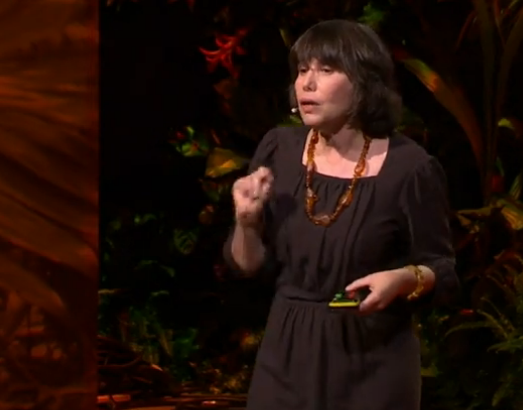So to test this we used a machine that we have called the Blicket Detector.
為了證明這個觀點,我們用了一個叫做玩具偵探的儀器。
This is a box that lights up and plays music when you put some things on it and not others.
如果你在這個箱子上放一些東西,其它的上面不放,那它可以發光還伴有音樂。
And using this very simple machine, my lab and others have done dozens of studies showing just how good babies are at learning about the world.
用這個簡單的儀器,我的實驗和其它實驗做了幾十項研究,證明了小孩子們在理解世間萬物上是多么得聰明。
Let me mention just one that we did with Tumar Kushner, my student.
我舉一個例子,一個和我學生圖瑪庫什納做的實驗。
If I showed you this detector, you would be likely to think to begin with that the way to make the detector go would be to put a block on top of the detector.
單看這個儀器,你也許覺得,讓它開始運作的方式是將一塊積木擺在上面。
But actually, this detector works in a bit of a strange way.
但這個儀器其實有點奇怪。
Because if you wave a block over the top of the detector, something you wouldn't ever think of to begin with, the detector will actually activate two out of three times.
因為你如果在儀器的上方搖擺一塊積木三次,很多人一開始都不會這樣做,那這個儀器會被啟動兩次。
Whereas, if you do the likely thing, put the block on the detector, it will only activate two out of six times.
然而,如果你把積木擺在儀器的上面六次,那只有兩次會啟動。

So the unlikely hypothesis actually has stronger evidence. It looks as if the waving is a more effective strategy than the other strategy.
所以說看似不大可能發生的假設,其實有更有力的證據。搖擺看起來比其它方法更有效。
So we did just this; we gave four year-olds this pattern of evidence, and we just asked them to make it go.
我們做了這樣的實驗;給了4歲的孩子這個線索,然后問他們怎么才能啟動儀器。
And sure enough, the four year-olds used the evidence to wave the object on top of the detector.
這些孩子當然選擇用我們提供的線索,將手中的東西對著儀器搖。
Now there are two things that are really interesting about this. The first one is, again, remember, these are four year-olds.
實驗過程中有兩個有趣的發現。首先,記住這些孩子只有四歲。
They're just learning how to count. But unconsciously, they're doing these quite complicated calculations that will give them a conditional probability measure.
他們才剛剛學會數數。但是在沒有意識的情況下,他們會用復雜的計算來算出條件機率。
And the other interesting thing is that they're using that evidence to get to an idea, get to a hypothesis about the world, that seems very unlikely to begin with.
第二個有趣的發現是,他們會用提供的線索來尋找一個觀點,對世界定一個假設,一個不太能站得住腳的假設。
And in studies we've just been doing in my lab, similar studies, we've show that four year-olds are actually better at finding out an unlikely hypothesis than adults are when we give them exactly the same task.
在我實驗室里的類似研究,我們發現4歲的小孩在相同的任務下,比大人更擅長找那個不大可能發生的假設。
So in these circumstances, the children are using statistics to find out about the world,
在這些情況下,小孩子用統計來了解世界,
but after all, scientists also do experiments, and we wanted to see if children are doing experiments.
但科學家會做實驗。所以我們想知道小孩會不會也在做實驗。
When children do experiments we call it "getting into everything" or else "playing."
小孩做的實驗我們稱它為“嘗試每一種可能” 或者是“玩一玩。”











